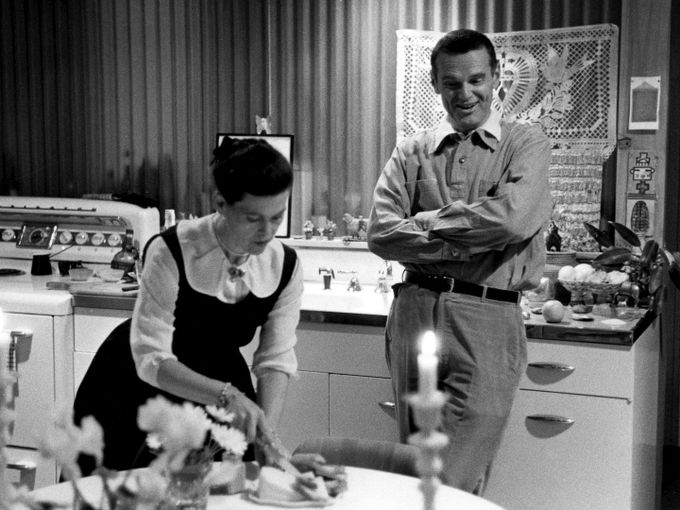Tea Ceremony at the Eames House
Connections between Japan and the Eameses

Charles und Ray Eames were endlessly curious – about people, cultures, traditions and the many ways of living and creating. Their home in Pacific Palisades was not only a place of work and play but also a stage for encounters that blended art, friendship and cultural exchange. One such occasion was when the Eames House became the setting for a Japanese tea ceremony that beautifully expressed their openness to learning from others as well as their fascination with Japanese aesthetics.
In 1951 Charles und Ray EamesIsamu NoguchiIsamu Noguchi, to the actress Yoshiko ‘Shirley’ Yamaguchi. The guests included other remarkable figures such as Charlie Chaplin, avant-garde poet Iris Tree and actor Ford Rainey. The Japanese tea was served on the Eameses’ low-set Occasional Table LTR while Noguchi’s Akari Light Sculptures softly illuminated the living room.
In 1951 Charles und Ray EamesIsamu NoguchiIsamu Noguchi, to the actress Yoshiko ‘Shirley’ Yamaguchi. The guests included other remarkable figures such as Charlie Chaplin, avant-garde poet Iris Tree and actor Ford Rainey. The Japanese tea was served on the Eameses’ low-set Occasional Table LTR while Noguchi’s Akari Light Sculptures softly illuminated the living room.


Photographs from the gathering show a bare Eames House interior carefully arranged for this special event – reduced to a few tatami mats, LTR tables and Akari lights strategically placed in the vast living room next to the glass-walled corner. This minimalist setting embodied the couple’s admiration for Japanese artistry and design.
Although Charles and Ray had not yet visited Japan when they built their home, its design already reflected Japanese influences. Their close connections with Noguchi and other Japanese artists reinforced this bond. In 1950 they met designer Isamu Kenmochi, and in 1955 the painter Genichiro Inokuma visited the house. The year of the tea ceremony, the Eameses also welcomed Genshitsu Sen, the 15th-generation grandmaster of the Urasenke Tea School. Encounters such as these nourished their regard for Japanese culture, which became even more pronounced following their later travels to Japan.
Although Charles and Ray had not yet visited Japan when they built their home, its design already reflected Japanese influences. Their close connections with Noguchi and other Japanese artists reinforced this bond. In 1950 they met designer Isamu Kenmochi, and in 1955 the painter Genichiro Inokuma visited the house. The year of the tea ceremony, the Eameses also welcomed Genshitsu Sen, the 15th-generation grandmaster of the Urasenke Tea School. Encounters such as these nourished their regard for Japanese culture, which became even more pronounced following their later travels to Japan.
This openness was deeply rooted in who Charles and Ray were. They were insatiably curious people, with a profound interest in other cultures, traditions and ways of living. Whether it was how a meal was prepared, a table set or a ceremony performed, they treated such practices with appreciation, seeing them as opportunities to learn. They believed that even the smallest details of daily life could spark creativity, and they approached unfamiliar customs not as outsiders looking in but as students eager to absorb knowledge from those who knew more. This generosity of spirit – always inquisitive, always open – fed their imagination and kept their work connected to the world around them.


The Eames House itself shares many qualities with traditional Japanese architecture. Its steel-and-glass frame creates a seamless transition between inside and outside, echoing the openness of Japanese houses. The two courtyards – one between the house and studio, the other to the south – are laid out on a modular grid, combining grass, brick and wood with restrained planting. Like a Japanese garden, the design emphasises texture and contrast. In the south courtyard, a single bonsai tree stands out against the red bricks, a subtle yet striking detail that is still visible today.
The Eameses themselves drew parallels between their house and Japanese architecture. In a letter from 1951, Charles observed how traditional Japanese buildings, made from modest materials, achieve remarkable harmony with human needs and scale. For Charles and Ray, the Eames House shared this quality: ‘The most important thing [the house] has in common with the Japanese teahouse is the fact that it uses extremely humble materials in a natural and uncontrived way.’ He similarly noted how bare I-beams and open steel lattices could serve the same role as exposed wooden beams in a teahouse. In this way, the tea ceremony of 1951 was not just a social gathering but also a moment that revealed the deep connections between the Eameses’ architecture, their friendships, their insatiable curiosity and their growing fascination with Japanese culture.
The Eameses themselves drew parallels between their house and Japanese architecture. In a letter from 1951, Charles observed how traditional Japanese buildings, made from modest materials, achieve remarkable harmony with human needs and scale. For Charles and Ray, the Eames House shared this quality: ‘The most important thing [the house] has in common with the Japanese teahouse is the fact that it uses extremely humble materials in a natural and uncontrived way.’ He similarly noted how bare I-beams and open steel lattices could serve the same role as exposed wooden beams in a teahouse. In this way, the tea ceremony of 1951 was not just a social gathering but also a moment that revealed the deep connections between the Eameses’ architecture, their friendships, their insatiable curiosity and their growing fascination with Japanese culture.

Veröffentlichungsdatum: 13.11.2025
Bilder: 1.–5. © 2025 Eames Office, LLC. All rights reserved.; 6. © Vitra


